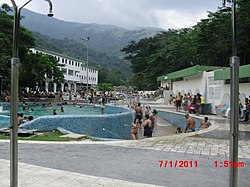History
Visit of Humboldt
The springs were visited by Alexander von Humboldt in 1800 during his expedition to the American tropics. [2] They were known to the locals and Humboldt noticed that sick people were taking steam baths there.
On his return to Europe, Humboldt made Las Trincheras known to science. He had recorded the temperature of the water as 90.3 °C (194.5 °F). There was no evidence of vulcanism in the area to explain what was heating the water. The work of François Arago on the geothermal gradient helped Humboldt to develop the idea that the springs obtained their heat from very deep groundwater circulation. [3]
Railway infrastructure
The development of the springs as a resort ( balneario in Spanish) was given a boost by the arrival of the Puerto Cabello and Valencia Railway in the 1880s. A station was opened at Las Trincheras, [4] but the railway closed in the 1950s as road transport became more important in Venezuela.
In the 21st century a new railway is being built connecting Puerto Cabello to La Encrucijada in Aragua. Among the tunnels on the line is the 7,702 m Bárbula Tunnel, between Las Trincheras and Naguanagua, which has been described as the longest in South America. [5]
This page is based on this
Wikipedia article Text is available under the
CC BY-SA 4.0 license; additional terms may apply.
Images, videos and audio are available under their respective licenses.

